Enhanced Photoelectrochemical Water Splitting Performance of Ce-Doped TiO2 Nanorod Array Photoanodes for Efficient Hydrogen Production
Abstract
1. Introduction
2. Results
2.1. Structure and Morphology
2.2. Photocatalytic Hydrogen Evolution Test of Ce-Doped TiO2 Photoanodes
2.3. Photoelectrochemical Performance Analysis of Ce-Doped TiO2 Photoanode
3. Materials and Methods
3.1. Synthesis Methods
3.2. Characterization
3.3. Catalytic Evaluation
4. Conclusions
Supplementary Materials
Author Contributions
Funding
Data Availability Statement
Conflicts of Interest
References
- Eidsvåg, H.; Bentouba, S.; Vajeeston, P.; Yohi, S.; Velauthapillai, D. TiO2 as a Photocatalyst for Water Splitting—An Experimental and Theoretical Review. Molecules 2021, 26, 1687. [Google Scholar] [CrossRef] [PubMed]
- Purabgola, A.; Mayilswamy, N.; Kandasubramanian, B. Graphene-based TiO2 composites for photocatalysis & environmental remediation: Synthesis and progress. Environ. Sci. Pollut. Res. 2022, 29, 32305–32325. [Google Scholar] [CrossRef]
- Li, R.; Weng, Y.; Zhou, X.; Wang, X.; Mi, Y.; Chong, R.; Han, H.; Li, C. Achieving overall water splitting using titanium dioxide-based photocatalysts of different phases. Energy Environ. Sci. 2015, 8, 2377–2382. [Google Scholar] [CrossRef]
- Li, H.; Liu, H.; Wang, F.; Li, G.; Wang, X.; Tang, Z. Hot electron assisted photoelectrochemical water splitting from Au-decorated ZnO@TiO2 nanorods array. Nano Res. 2022, 15, 5824–5830. [Google Scholar] [CrossRef]
- Gao, C.; Wei, T.; Zhang, Y.; Song, X.; Huan, Y.; Liu, H.; Zhao, M.; Yu, J.; Chen, X. A Photoresponsive Rutile TiO2 Heterojunction with Enhanced Electron–Hole Separation for High-Performance Hydrogen Evolution. Adv. Mater. 2019, 31, e1806596. [Google Scholar] [CrossRef] [PubMed]
- Wang, H.; Jiang, H.; Huo, P.; Edelmannová, M.F.; Čapek, L.; Kočí, K. Hydrogen production from methanol-water mixture over NiO/TiO2 nanorods structure photocatalysts. J. Environ. Chem. Eng. 2022, 10, 106908. [Google Scholar] [CrossRef]
- Chen, S.; Liu, W.; Zhang, S.; Chen, Y. Preparation and activity evaluation of relative p–n junction photocatalyst Co-TiO2/TiO2. J. Sol-Gel Sci. Technol. 2010, 54, 258–267. [Google Scholar] [CrossRef]
- Prakash, J.; Samriti; Kumar, A.; Dai, H.; Janegitz, B.C.; Krishnan, V.; Swart, H.C.; Sun, S. Novel rare earth metal–doped one-dimensional TiO2 nanostructures: Fundamentals and multifunctional applications. Mater. Today Sustain. 2021, 13, 100066. [Google Scholar] [CrossRef]
- Li, J.; Yang, X.; Yu, X.; Xu, L.; Kang, W.; Yan, W.; Gao, H.; Liu, Z.; Guo, Y. Rare earth oxide-doped titania nanocomposites with enhanced photocatalytic activity towards the degradation of partially hydrolysis polyacrylamide. Appl. Surf. Sci. 2009, 255, 3731–3738. [Google Scholar] [CrossRef]
- Du, P.; Bueno-López, A.; Verbaas, M.; Almeida, A.; Makkee, M.; Moulijn, J.; Mul, G. The effect of surface OH-population on the photocatalytic activity of rare earth-doped P25-TiO2 in methylene blue degradation. J. Catal. 2008, 260, 75–80. [Google Scholar] [CrossRef]
- Pepin, P.A.; Lee, J.D.; Murray, C.B.; Vohs, J.M. Thermal and Photocatalytic Reactions of Methanol and Acetaldehyde on Pt-Modified Brookite TiO2 Nanorods. ACS Catal. 2018, 8, 11834–11846. [Google Scholar] [CrossRef]
- Pu, Y.-C.; Wang, G.; Chang, K.-D.; Ling, Y.; Lin, Y.-K.; Fitzmorris, B.C.; Liu, C.-M.; Lu, X.; Tong, Y.; Zhang, J.Z.; et al. Au Nanostructure-Decorated TiO2 Nanowires Exhibiting Photoactivity Across Entire UV-visible Region for Photoelectrochemical Water Splitting. Nano Lett. 2013, 13, 3817–3823. [Google Scholar] [CrossRef] [PubMed]
- Zhou, Q.; Chen, Y.; Shi, H.; Chen, R.; Ji, M.; Li, K.; Wang, H.; Jiang, X.; Lu, C. The Construction of p/n-Cu2O Heterojunction Catalysts for Efficient CO2 Photoelectric Reduction. Catalysts 2023, 13, 857. [Google Scholar] [CrossRef]
- Chen, R.; Wang, Y.-Y.; Jiang, X.; Ji, M.-H.; Li, K.-X.; Shi, H.-Y.; Wang, H.-L.; Chen, Y.-X.; Lu, C.-Z. Lotus pollen-derived nitrogen and phosphorus self-doped TiO2/carbon materials for photoelectrochemical application. J. Environ. Chem. Eng. 2024, 12, 112743. [Google Scholar] [CrossRef]
- Pal, B.; Bakr, Z.H.; Krishnan, S.G.; Yusoff, M.M.; Jose, R. Large scale synthesis of 3D nanoflowers of SnO2/TiO2 composite via electrospinning with synergistic properties. Mater. Lett. 2018, 225, 117–121. [Google Scholar] [CrossRef]
- Ghafourian, N.; Hosseini, S.N.; Mahmoodi, Z.; Masnabadi, N.; Thalji, M.R.; Abhari, A.R.; Al Zoubi, W.; Chong, K.F.; Ali, G.A.M.; Bakr, Z.H. TiO2-Mica 450 composite for photocatalytic degradation of methylene blue using UV irradiation. Emergent Mater. 2023, 6, 1527–1536. [Google Scholar] [CrossRef]
- Kisumi, T.; Tsujiko, A.; Murakoshi, K.; Nakato, Y. Crystal-face and illumination intensity dependences of the quantum efficiency of photoelectrochemical etching, in relation to those of water photooxidation, at n-TiO2 (rutile) semiconductor electrodes. J. Electroanal. Chem. 2003, 545, 99–107. [Google Scholar] [CrossRef]
- Hoang, S.; Berglund, S.P.; Hahn, N.T.; Bard, A.J.; Mullins, C.B. Enhancing Visible Light Photo-oxidation of Water with TiO2 Nanowire Arrays via Cotreatment with H2 and NH3: Synergistic Effects between Ti3+ and N. J. Am. Chem. Soc. 2012, 134, 3659–3662. [Google Scholar] [CrossRef]
- Fan, Z.; Meng, F.; Gong, J.; Li, H.; Ding, Z.; Ding, B. One-step hydrothermal synthesis of mesoporous Ce-doped anatase TiO2 nanoparticles with enhanced photocatalytic activity. J. Mater. Sci. Mater. Electron. 2016, 27, 11866–11872. [Google Scholar] [CrossRef]
- Tian, M.; Wang, H.; Sun, D.; Peng, W.; Tao, W. Visible light driven nanocrystal anatase TiO2 doped by Ce from sol–gel method and its photoelectrochemical water splitting properties. Int. J. Hydrogen Energy 2014, 39, 13448–13453. [Google Scholar] [CrossRef]
- de Lima, J.F.; Harunsani, M.H.; Martin, D.J.; Kong, D.; Dunne, P.W.; Gianolio, D.; Kashtiban, R.J.; Sloan, J.; Serra, O.A.; Tang, J.; et al. Control of chemical state of cerium in doped anatase TiO2 by solvothermal synthesis and its application in photocatalytic water reduction. J. Mater. Chem. A 2015, 3, 9890–9898. [Google Scholar] [CrossRef]
- Tong, M.-H.; Chen, Y.-X.; Wang, T.-M.; Lin, S.-W.; Li, G.; Zhou, Q.-Q.; Chen, R.; Jiang, X.; Liao, H.-G.; Lu, C.-Z. Cerium Synchronous Doping in Anatase for Enhanced Photocatalytic Hydrogen Production from Ethanol-Water Mixtures. Molecules 2023, 28, 2433. [Google Scholar] [CrossRef] [PubMed]
- Tong, M.-H.; Chen, Y.-X.; Lin, S.-W.; Zhao, H.-P.; Chen, R.; Jiang, X.; Shi, H.-Y.; Zhu, M.-L.; Zhou, Q.-Q.; Lu, C.-Z. Synchronous electrochemical anodization: A novel strategy for preparing cerium doped TiO2 nanotube arrays toward visible-light PEC water splitting. Electrochim. Acta 2023, 463, 142793. [Google Scholar] [CrossRef]
- Lin, S.-W.; Tong, M.-H.; Chen, Y.-X.; Chen, R.; Zhao, H.-P.; Jiang, X.; Yang, K.; Lu, C.-Z. CeO2/TiO2 Heterojunction Nanotube Arrays for Highly Efficient Visible-Light Photoelectrochemical Water Splitting. ACS Appl. Energy Mater. 2023, 6, 1093–1102. [Google Scholar] [CrossRef]
- Chen, Y.; Lavacchi, A.; Chen, S.; di Benedetto, F.; Bevilacqua, M.; Bianchini, C.; Fornasiero, P.; Innocenti, M.; Marelli, M.; Oberhauser, W.; et al. Electrochemical Milling and Faceting: Size Reduction and Catalytic Activation of Palladium Nanoparticles. Angew. Chem. Int. Ed. 2012, 51, 8500–8504. [Google Scholar] [CrossRef]
- Laczai, N.; Kovács, L.; Kocsor, L.; Bencs, L. Influence of LiF additive and cerium doping on photoluminescence properties of polycrystalline YSO and LYSO. Mater. Res. Bull. 2021, 133, 111018. [Google Scholar] [CrossRef]
- Sibu, C.P.; Kumar, S.R.; Mukundan, P.; Warrier, K.G.K. Structural Modifications and Associated Properties of Lanthanum Oxide Doped Sol−Gel Nanosized Titanium Oxide. Chem. Mater. 2002, 14, 2876–2881. [Google Scholar] [CrossRef]
- Nasir, M.; Bagwasi, S.; Jiao, Y.; Chen, F.; Tian, B.; Zhang, J. Characterization and activity of the Ce and N co-doped TiO2 prepared through hydrothermal method. Chem. Eng. J. 2014, 236, 388–397. [Google Scholar] [CrossRef]
- Padmini, E.; Miranda, L.R. Nanocatalyst from sol–sol doping of TiO2 with Vanadium and Cerium and its application for 3,4 Dichloroaniline degradation using visible light. Chem. Eng. J. 2013, 232, 249–258. [Google Scholar] [CrossRef]
- Mukhopadhyay, K.; Ghosh, U.C.; Sasikumar, P. Enhanced capacity of fluoride scavenging from contaminated water by nano-architectural reorientation of cerium-incorporated hydrous iron oxide with graphene oxide. Environ. Sci. Pollut. Res. 2019, 26, 26112–26133. [Google Scholar] [CrossRef]
- Zhao, H.-P.; Zhu, M.-L.; Shi, H.-Y.; Zhou, Q.-Q.; Chen, R.; Lin, S.-W.; Tong, M.-H.; Ji, M.-H.; Jiang, X.; Liao, C.-X.; et al. Cerium-Doped Iron Oxide Nanorod Arrays for Photoelectrochemical Water Splitting. Molecules 2022, 27, 9050. [Google Scholar] [CrossRef] [PubMed]
- Kotani, A.; Jo, T.; Parlebas, J. Many-body effects in core-level spectroscopy of rare-earth compounds. Adv. Phys. 1988, 37, 37–85. [Google Scholar] [CrossRef]
- Duquet, F.; Flaud, V.; Villeneuve-Faure, C.; Rivallin, M.; Rouessac, F.; Roualdès, S. Hybrid Photoelectrocatalytic TiO2-Co3O4/Co(OH)2 Materials Prepared from Bio-Based Surfactants for Water Splitting. Molecules 2023, 28, 7599. [Google Scholar] [CrossRef]
- Wang, Y.; Zhao, Y.; Zhu, P.; Wu, X.; Koshayeva, A.; Ding, L.; Wei, G.; Su, Y. A promising one-step carbothermal reduction nitridation strategy for enhancing photoelectrochemical performance of TiO2 nanowire array-based catalysts with stable nitrogen doping and desired core-double shell structure. Appl. Surf. Sci. 2023, 639, 158261. [Google Scholar] [CrossRef]
- Nada, A.A.; Bekheet, M.F.; Samélor, D.; Vergnes, H.; Villeneuve-Faure, C.; Cartier, J.; Charmette, C.; Tingry, S.; Caussat, B.; Vahlas, C.; et al. Photo-electrocatalytic performance of poly(3,4-ethylenedioxythiophene)/TiO2 nano-tree films deposited by oCVD/CVD for H2 production. Appl. Surf. Sci. 2023, 637, 157919. [Google Scholar] [CrossRef]
- Wang, J.; Zhuang, C.; Zhu, Y.; Wang, X.; Zhang, W.; Liu, Y.; Yang, D. Ternary TiO2/Ni–Ni(OH)2/NiPi nanotube arrays with synergetic effect for enhanced photoelectrocatalytic H2-evolution. Int. J. Hydrogen Energy 2022, 47, 22063–22077. [Google Scholar] [CrossRef]
- Feng, W.; Lin, L.; Li, H.; Chi, B.; Pu, J.; Li, J. Hydrogenated TiO2/ZnO heterojunction nanorod arrays with enhanced performance for photoelectrochemical water splitting. Int. J. Hydrogen Energy 2017, 42, 3938–3946. [Google Scholar] [CrossRef]
- Zhang, Z.; Shi, C.; Lv, K.; Ma, C.; Xiao, G.; Ni, L. 200-nm long TiO2 nanorod arrays for efficient solid-state PbS quantum dot-sensitized solar cells. J. Energy Chem. 2018, 27, 1214–1218. [Google Scholar] [CrossRef]
- Yang, C.; Lv, Y.; Zhang, H.; Zhou, X. Double-shelled ZnO/TiO2/CdS nanorod arrays for enhanced photoelectrocatalytic performance. J. Porous Mater. 2019, 26, 903–912. [Google Scholar] [CrossRef]
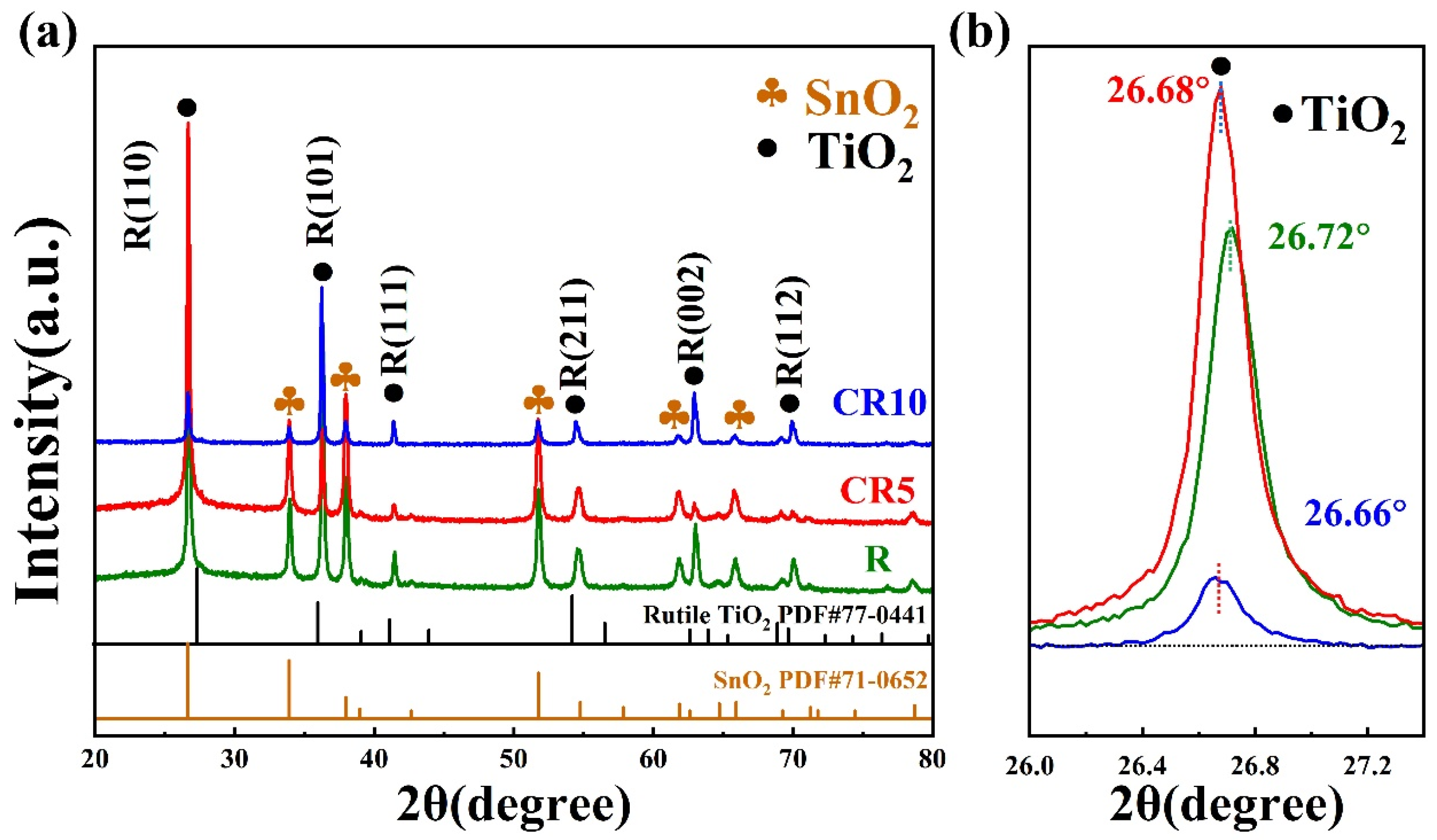
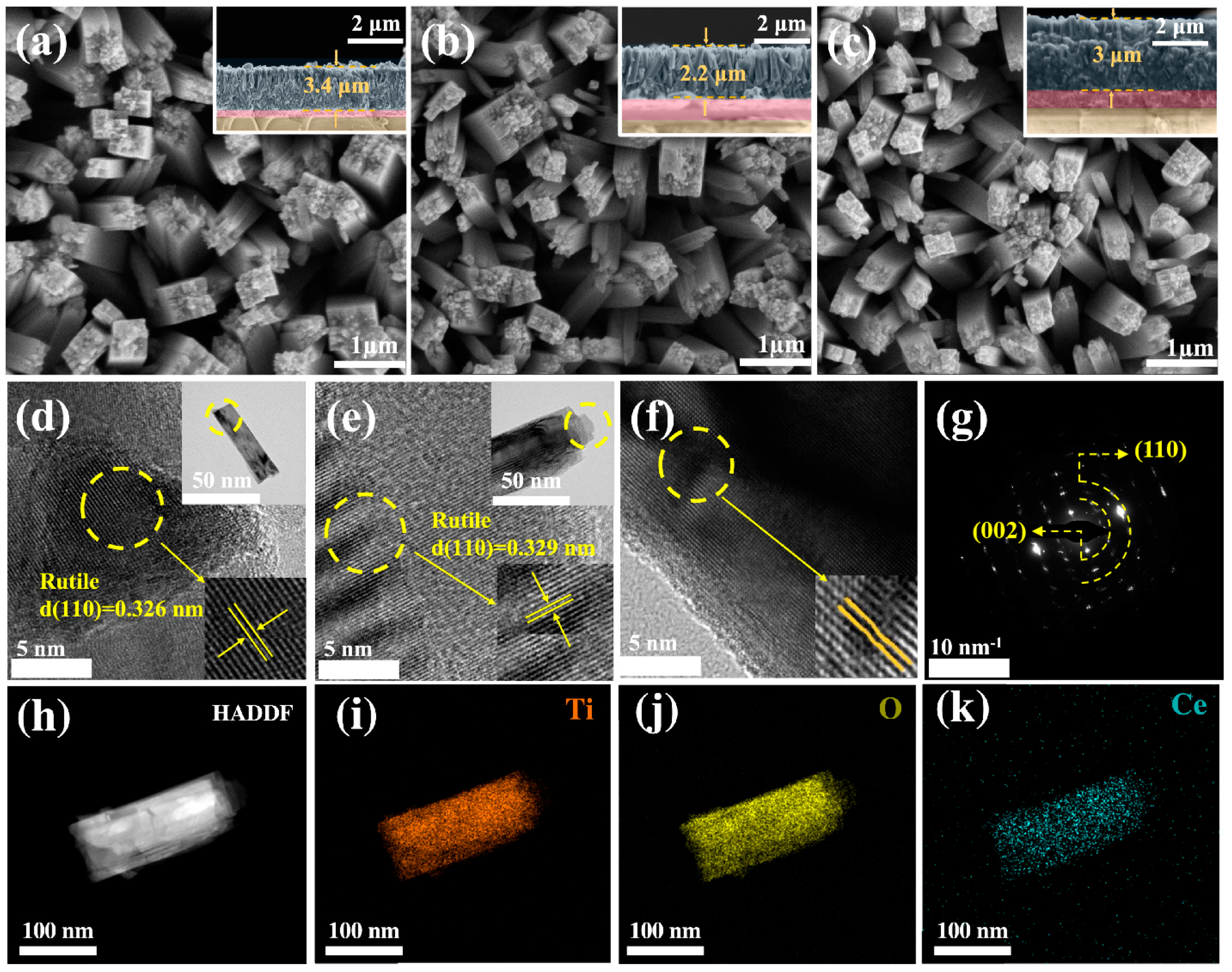

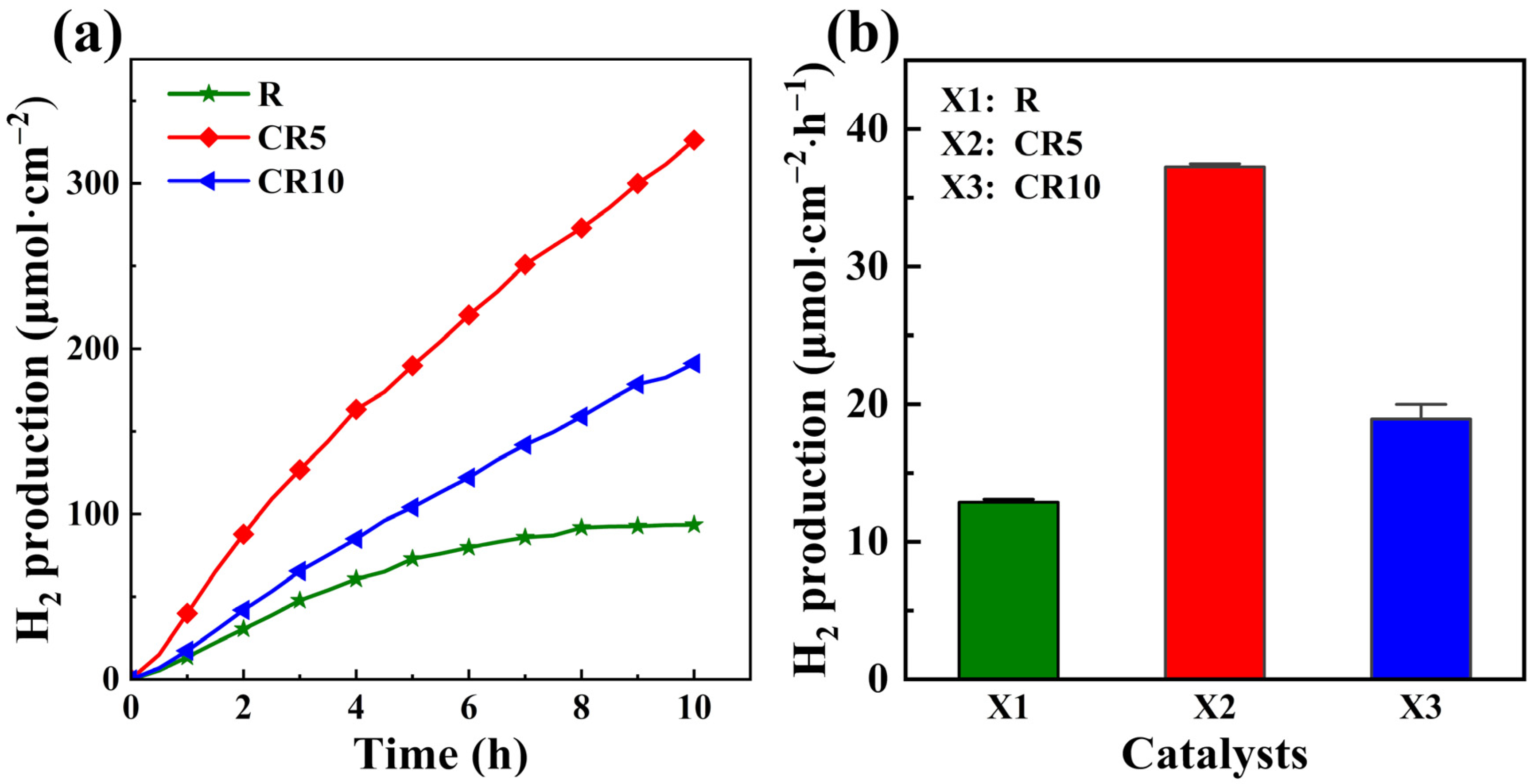


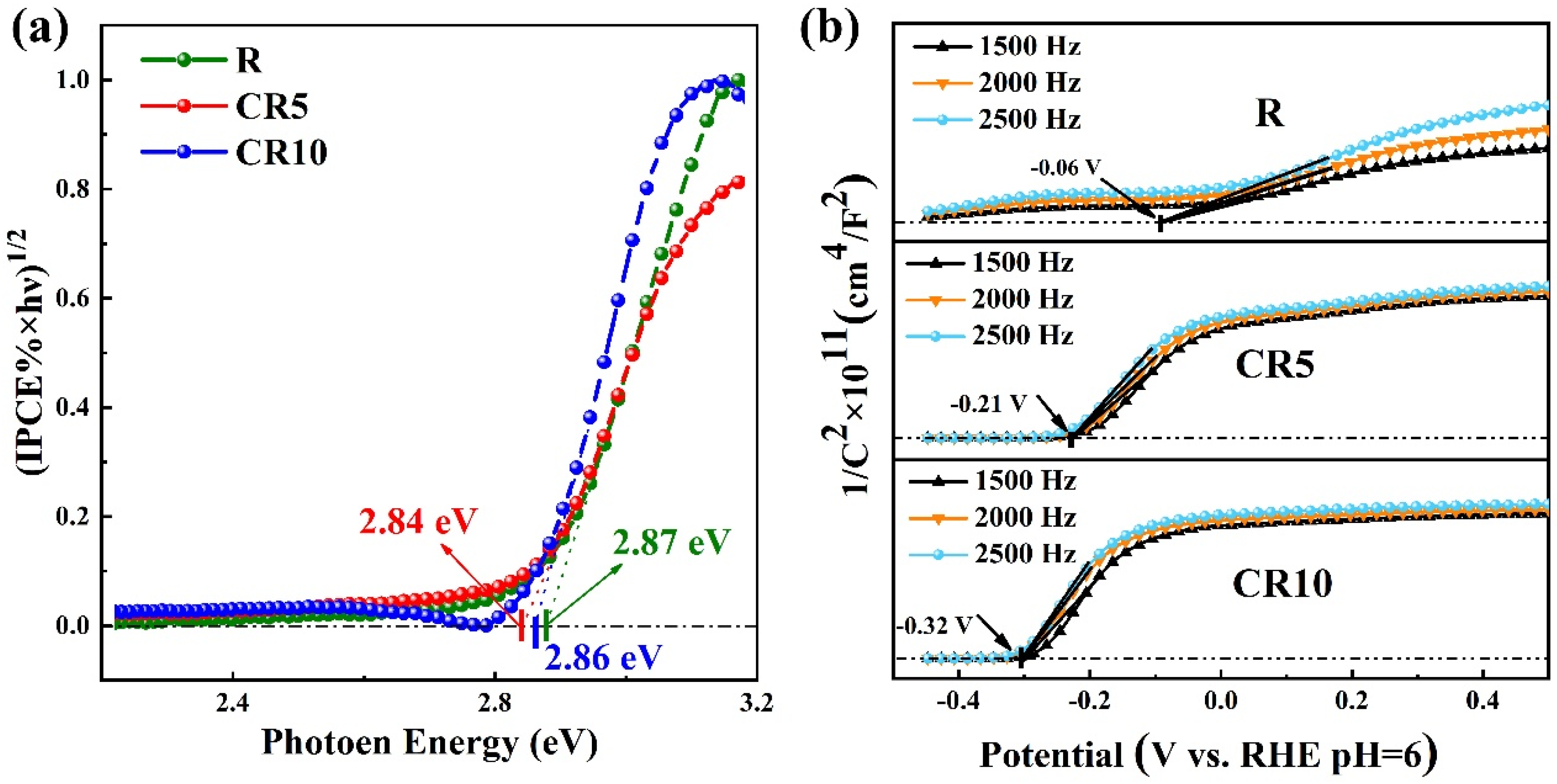

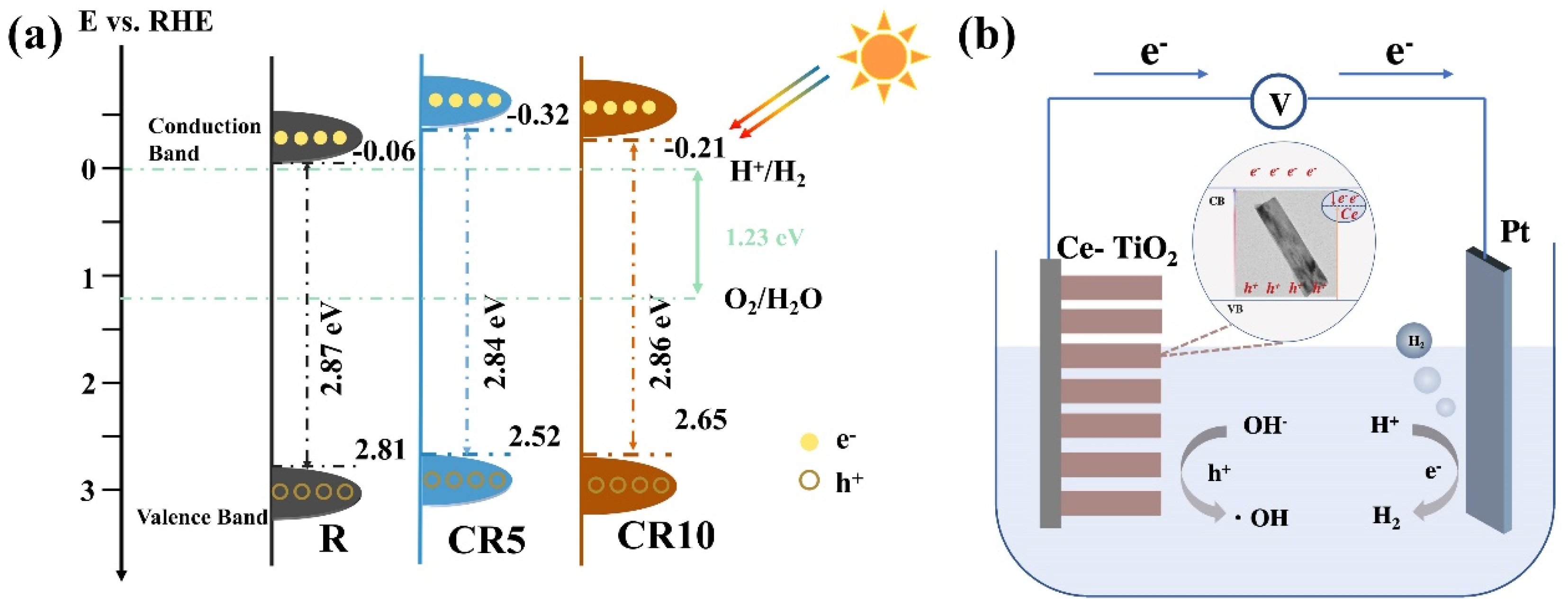
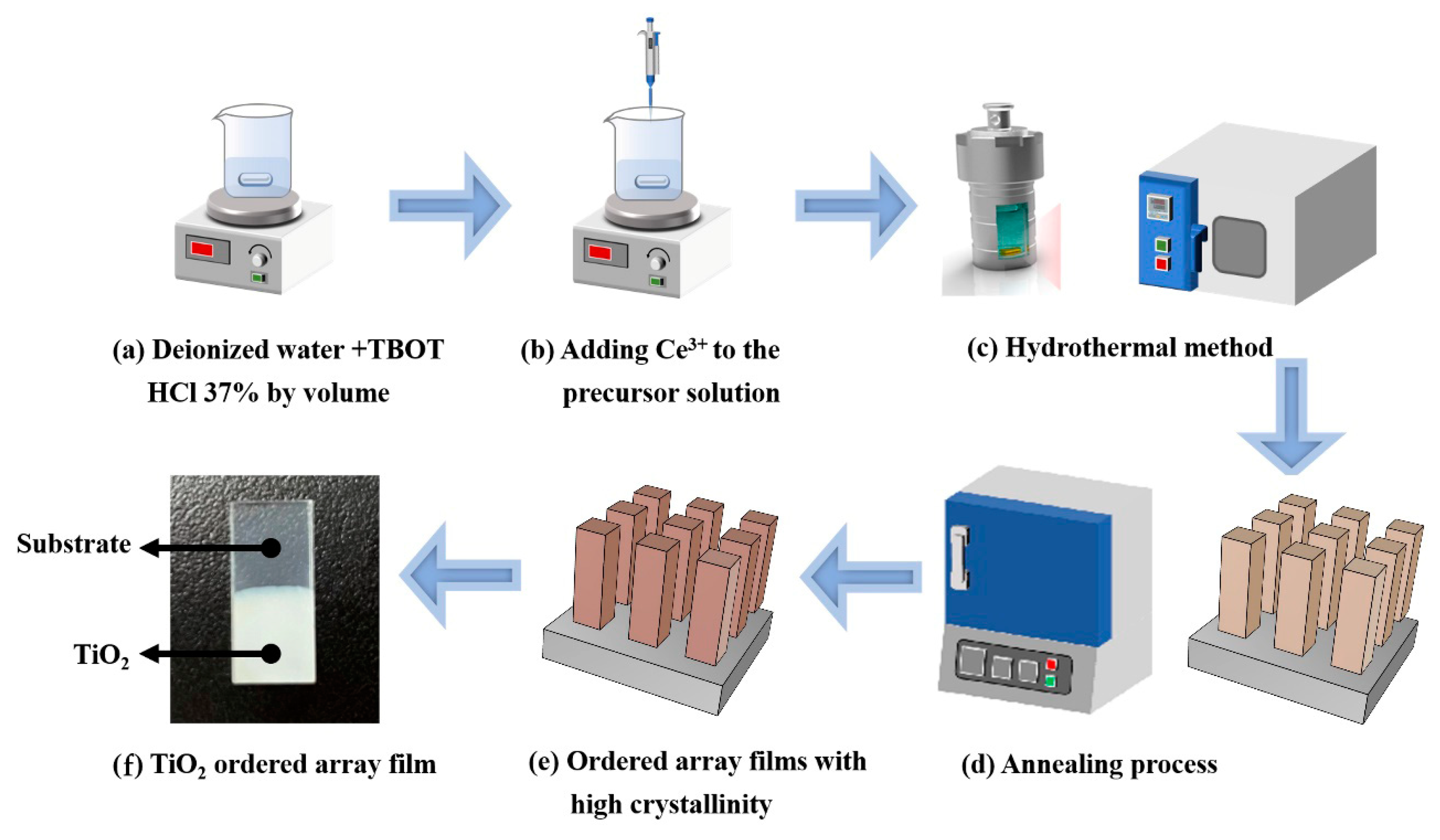
| Catalyst | Light Source | Current Density | H2 Production | Ref. |
|---|---|---|---|---|
| Ce-TiO2 | 300 W Xenon lamp | - | 4972 µmol·g−1·h−1 | [21] |
| Ce-TiO2 | AM 1.5G | 0.0109 mA/cm2 | 0.33 μmol·g−1·h−1 | [22] |
| CeO2/TNT | AM 1.5G | 2.11 mA/cm2 (1.55 V vs. RHE) | 17.86 µmol·cm−2·h−1 | [23] |
| Ce-TNT | AM 1.5G | 3.5 mA/cm2 (1.0 V vs. Ag/AgCl) | 43.07 µmol·cm−2·h−1 | [24] |
| TiO2-Co3O4/Co(OH)2 | 75 W LOT Quantum | 1.570 mA/cm2 | 0.3 µmol·cm−2·min−1 | [33] |
| N-TiO2/Ti(CN)/N-C | 300 W Xenon lamp | 458.6 μA/cm2 | - | [34] |
| PEDOT/TiO2 | 100 W Xenon lamp | 0.26 mA/cm2 | 4.1 µmol·cm−2·h−1 | [35] |
| TNTAs/Ni–Ni(OH)2/NiPi | 500 W xenon lamp | 2.32 mA/cm2 | 56.65 µmol·cm−2·h−1 | [36] |
| Ce-Doped TiO2 | 300 W xenon lamp | 1.98 mA/cm2 | 37.03 µmol·cm−2·h−1 | This work |
Disclaimer/Publisher’s Note: The statements, opinions and data contained in all publications are solely those of the individual author(s) and contributor(s) and not of MDPI and/or the editor(s). MDPI and/or the editor(s) disclaim responsibility for any injury to people or property resulting from any ideas, methods, instructions or products referred to in the content. |
© 2024 by the authors. Licensee MDPI, Basel, Switzerland. This article is an open access article distributed under the terms and conditions of the Creative Commons Attribution (CC BY) license (https://creativecommons.org/licenses/by/4.0/).
Share and Cite
Lin, B.-L.; Chen, R.; Zhu, M.-L.; She, A.-S.; Chen, W.; Niu, B.-T.; Chen, Y.-X.; Lin, X.-M. Enhanced Photoelectrochemical Water Splitting Performance of Ce-Doped TiO2 Nanorod Array Photoanodes for Efficient Hydrogen Production. Catalysts 2024, 14, 639. https://doi.org/10.3390/catal14090639
Lin B-L, Chen R, Zhu M-L, She A-S, Chen W, Niu B-T, Chen Y-X, Lin X-M. Enhanced Photoelectrochemical Water Splitting Performance of Ce-Doped TiO2 Nanorod Array Photoanodes for Efficient Hydrogen Production. Catalysts. 2024; 14(9):639. https://doi.org/10.3390/catal14090639
Chicago/Turabian StyleLin, Bi-Li, Rui Chen, Mei-Ling Zhu, Ao-Sheng She, Wen Chen, Bai-Tong Niu, Yan-Xin Chen, and Xiu-Mei Lin. 2024. "Enhanced Photoelectrochemical Water Splitting Performance of Ce-Doped TiO2 Nanorod Array Photoanodes for Efficient Hydrogen Production" Catalysts 14, no. 9: 639. https://doi.org/10.3390/catal14090639
APA StyleLin, B.-L., Chen, R., Zhu, M.-L., She, A.-S., Chen, W., Niu, B.-T., Chen, Y.-X., & Lin, X.-M. (2024). Enhanced Photoelectrochemical Water Splitting Performance of Ce-Doped TiO2 Nanorod Array Photoanodes for Efficient Hydrogen Production. Catalysts, 14(9), 639. https://doi.org/10.3390/catal14090639








